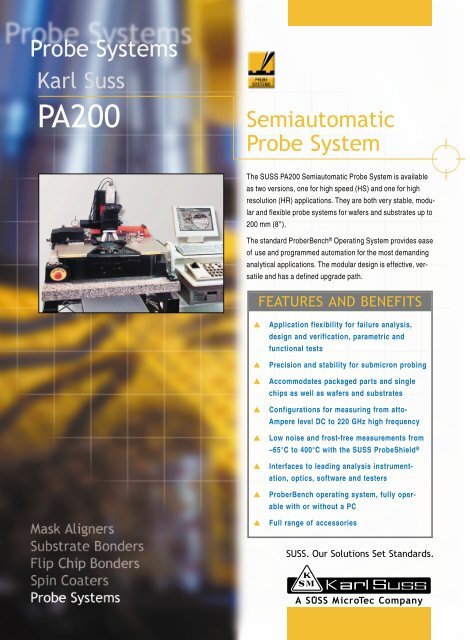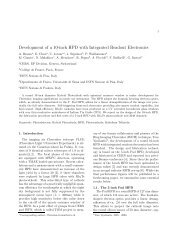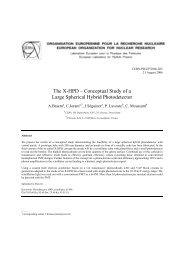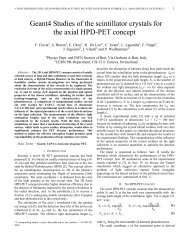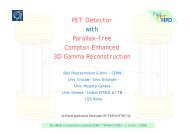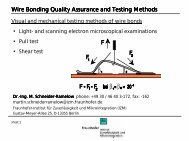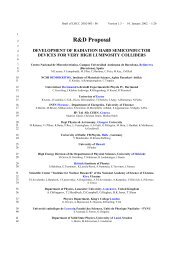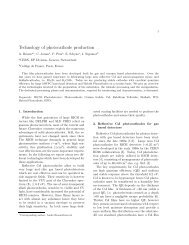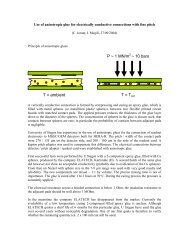Karl Suss Semiautomatic Probe System
Karl Suss Semiautomatic Probe System
Karl Suss Semiautomatic Probe System
You also want an ePaper? Increase the reach of your titles
YUMPU automatically turns print PDFs into web optimized ePapers that Google loves.
<strong>Karl</strong> <strong>Suss</strong><br />
PA200<br />
<strong>Semiautomatic</strong><br />
<strong>Probe</strong> <strong>System</strong><br />
The SUSS PA200 <strong>Semiautomatic</strong> <strong>Probe</strong> <strong>System</strong> is available<br />
as two versions, one for high speed (HS) and one for high<br />
resolution (HR) applications. They are both very stable, modular<br />
and flexible probe systems for wafers and substrates up to<br />
200 mm (8).<br />
The standard <strong>Probe</strong>rBench ® Operating <strong>System</strong> provides ease<br />
of use and programmed automation for the most demanding<br />
analytical applications. The modular design is effective, versatile<br />
and has a defined upgrade path.<br />
FEATURES AND BENEFITS<br />
▲ Application flexibility for failure analysis,<br />
design and verification, parametric and<br />
functional tests<br />
▲ Precision and stability for submicron probing<br />
▲ Accommodates packaged parts and single<br />
chips as well as wafers and substrates<br />
▲ Configurations for measuring from atto-<br />
Ampere level DC to 220 GHz high frequency<br />
▲ Low noise and frost-free measurements from<br />
–65°C to 400°C with the SUSS <strong>Probe</strong>Shield ®<br />
▲ Interfaces to leading analysis instrumentation,<br />
optics, software and testers<br />
▲ <strong>Probe</strong>rBench operating system, fully operable<br />
with or without a PC<br />
▲ Full range of accessories<br />
SUSS. Our Solutions Set Standards.<br />
A SU <br />
SS MicroTec Company
2<br />
Improve your Yield<br />
OUR SOLUTIONS SET STANDARDS<br />
Challenges ...<br />
Analytical DC test High frequency test Automated MCM test<br />
The value of failure analysis increases as its impact on customer<br />
satisfaction, yield, quality and reliability is realized. This<br />
reliance on failure analysis, combined with greater circuit complexity<br />
and smaller structures, enhances the role of semiautomatic<br />
probers.<br />
Versatility<br />
Where a failure analysis lab once handled only packaged parts<br />
or wafers, it is now routinely asked to analyze a device at any<br />
stage of its lifecycle: from the wafer fab to an end user return.<br />
A prober must quickly adapt to handle products from wafers<br />
and single chips to packaged parts.<br />
Return on Investment<br />
The cost of failure analysis will grow, particularly for leading<br />
edge technology, necessitating higher equipment utilization<br />
and demanding a better return on investment.<br />
Interfacing<br />
Failure analysis, typically characterized as a hands-on procedure,<br />
manually placing probes and adjusting the device, has<br />
progressed to programmed automation for acquiring statistically<br />
relevant data across a wafer.<br />
A prober must interface to an array of hardware and software<br />
instruments, including emission microscopes, laser cutters,<br />
data acquisition, CAD navigation software and other test<br />
equipment.<br />
Precision<br />
With the increase in the number of I/O pads and the decrease<br />
in feature size, a prober is expected to provide the rigidity<br />
required to use production probecards, as well as accuracy for<br />
in-circuit stepping routines. Simultaneous use of probecard<br />
and <strong>Probe</strong>Heads to contact submicron gates is required.<br />
Low Signal Measurements<br />
The quality of all low-signal and sensitive measurements is<br />
dependent on the noise floor of the measurement system. All<br />
low signal measurement concerns were taken into consideration<br />
when designing SUSS probing equipment. This gives optimal<br />
noise reduction with superior performance capabilities. The<br />
PA200 system with a <strong>Probe</strong>Shield ® is optimally configured for<br />
demanding low signal and frostfree low temperature testing.<br />
The unique design of the SUSS <strong>Probe</strong>Shield guarantees a<br />
light-tight, gas tight, electromagnetic shielded, and ultra low<br />
noise environment while testing. It is ideal for ultra low signal<br />
measurements in the AttoAmp, FemtoFarad and MicroVolt<br />
range.
Ease of Use<br />
Lab environments also influence<br />
the design of semiautomatic probers.<br />
In open labs with dozens of users,<br />
the prober must be simple and easy<br />
to operate. On the other hand, a prober<br />
with a dedicated user should also<br />
maximize performance.<br />
The SUSS PA200 <strong>Semiautomatic</strong><br />
<strong>Probe</strong> <strong>System</strong> meets these challenges<br />
through innovative design, precision<br />
and reliability.<br />
A Graphical User Interface provided<br />
by the renowned SUSS<br />
<strong>Probe</strong>rBench software makes<br />
the PA200 a fully functional,<br />
flexible yet simple tool where<br />
various set-ups can be stored<br />
for individual tasks.<br />
Precise Mechanics<br />
The SUSS PA200 <strong>Semiautomatic</strong> <strong>Probe</strong> <strong>System</strong> relies on a<br />
cast base frame and massively machined components to provide<br />
an extremely stable probing environment as well as software<br />
compensation. Precise resolution and accuracy results<br />
from using a ball-screw drive and glass scales in closed-loop<br />
positioning.<br />
Modular Design<br />
Laser Cutting<br />
Modular construction provides application flexibility and cost<br />
effectiveness. Microscope mounts include fixed, manual and<br />
programmable, as well as programmable focus and magnification.<br />
<strong>Probe</strong>Head platens are available for DC, HF and specialized<br />
applications, with fixed or manual movement.<br />
The standard chuck secures single chips to 8 wafers;<br />
optional chucks handle fragile III-V compound wafers and<br />
rectangular substrates.<br />
... and Solutions<br />
A typical CAD Navigation set-up<br />
Adaptation to the height differences between wafers and<br />
packaged parts is accomplished by the chuck and platen<br />
having 30/15 (HR/HS) and 20 mm of travel respectively, for<br />
approx. 50 mm (2) of working clearance. DUT boards are<br />
secured by vacuum to the standard wafer chuck, so chuck<br />
planarity is not affected.<br />
User-Friendly<br />
The <strong>Probe</strong>rBench ® Operating <strong>System</strong> is a powerful multitasking<br />
system with joystick controller, graphical and remote<br />
interfaces. The Windows ® based graphical interface includes<br />
Navigator on-screen joystick and setup, TableView spreadsheet,<br />
graphical WaferMap and optical VideoTracker navigation<br />
and data acquisition modules. Standard remote interfaces<br />
are IEEE488 and RS232. The prober is fully operable<br />
without a PC.<br />
3
4<br />
OUR SOLUTIONS SET STANDARDS<br />
Application flexibility<br />
PA200 with <strong>Probe</strong>Shield ® EMC for low signal and low temperature probing<br />
Application flexibility is defined by the diversity of applications,<br />
as well as the specific requirements of each. There are<br />
many aspects to consider: Measurement type and integrity,<br />
integration into a test system and how the user interacts<br />
with the system as well as mechanical stability and accuracy.<br />
SUSS addresses these issues with a modular or customer<br />
specific design and with our wide range of accessories.<br />
DC Parameter testing<br />
For DC parametrics, the software can be configured as a<br />
simple, easy to use interface for scanning a wafer during<br />
fast step-and-repeat patterns. Hardware choices include<br />
high pin-count probecard adapters, triaxial probes, chucks<br />
(standard and thermal), and the SUSS <strong>Probe</strong>Shield ® for low<br />
current and capacitance measurements. The unique Quiet<br />
Mode removes power to all motors to reduce the noise floor.<br />
SUSS precision allows the reliable, automatic probing of transistors<br />
and the smaller pads of monitor chips.<br />
Failure Analysis<br />
For failure analysis mechanical versatility provides quick<br />
changeover between packaged parts and wafers. The<br />
<strong>Probe</strong>rBench operating system has been integrated with<br />
the most common failure analysis tools, including emission<br />
microscopes, CAD navigation software, laser cutters and<br />
data acquisition/analysis software. All <strong>Probe</strong>Heads can<br />
be simultaneously used with a probecard and with active<br />
probes. SUSS stability allows the smallest features to be<br />
easily probed at the highest magnifications, especially<br />
when used with the SUSS MFI <strong>Probe</strong> for scanning and<br />
probing below 0.2 µm.<br />
High Frequency<br />
The SUSS PA200 has the stability for HF on-wafer probing<br />
without compromising flexibility. A complete range of accessories<br />
for probing up to 220 GHz is available and includes:<br />
<strong>Probe</strong>s, calibration substrates and software, positioners,<br />
chucks, cables and IC-CAP interfacing.<br />
Temperature Probing<br />
The SUSS <strong>Probe</strong>Shield also provides an innovative approach<br />
to probing down to –65°C. Frost-free low temperature probing<br />
requires that the air surrounding the cold chuck is pressurized,<br />
clean and dry. Just enough pressure is required to keep<br />
the ambient air out of the chamber. The air is dried so that its<br />
dew point is lower than the chuck temperature.<br />
For thermal low signal applications, SUSS supplies a range of<br />
low leakage thermal chucks up to 300°C.<br />
PA200 high frequency application
PH600<br />
Programmable<br />
<strong>Probe</strong>Head<br />
CCD Camera<br />
Microscope Motorized<br />
focus<br />
SUSS PA200 <strong>Semiautomatic</strong> <strong>Probe</strong> <strong>System</strong><br />
Microscope<br />
bridge<br />
The prober mechanics are based on a web-reinforced, aluminum<br />
casting for excellent rigidity and vibration damping.<br />
The wrap-around design places the stage and platen drives<br />
into, rather than on top of, the base further increasing stability.<br />
All surfaces are finished in cleanroom grade paint or are<br />
anodized.<br />
The X-Y stage is constructed of steel for temperature stability.<br />
Linear accuracy and torsional stiffness are enhanced<br />
with wide spaced bearings and the use of ground in place<br />
of the more typical rod and ball slides. A ball-screw drive is<br />
utilized which automatically compensates for wear and<br />
ensures the system will remain backlash-free. The DC servo<br />
closed loop positioning system uses linear encoders to<br />
read the actual stage position and to preclude leadscrew<br />
induced thermal errors. In addition to the superior mechanical<br />
design, two software compensation routines are used:<br />
linear and matrix. “Linear” adjusts positioning by an equal<br />
amount over the 200 mm travel range and can be used to<br />
correct thermal chuck induced wafer expansion/contraction.<br />
“Matrix” maps the stage throughout its travel for finer accuracy.<br />
Axes orthogonal error is also compensated. The Z and<br />
theta axes are DC servo closed loop driven.<br />
The Design<br />
PH150<br />
Analysis <strong>Probe</strong>Head<br />
Joystick<br />
controller<br />
<strong>Probe</strong>rBench<br />
User Interface<br />
The microscope is supported by a cast<br />
aluminum bridge for stability at the highest<br />
magnifications. The bridge design allows<br />
rearward access for cable routing. The<br />
cantilevered load of a microscope is<br />
a design challenge addressed by using<br />
bearing ways. The programmable microscope<br />
movement closed loop DC servo<br />
drive provides 50 mm of travel. Software<br />
compensation is used, and is aligned to<br />
the chuck stage for parallel movement<br />
between the stages. Programmable focus,<br />
and magnification on some microscope<br />
models, is also available.<br />
The <strong>Probe</strong>Head Platen is the most versatile component of a<br />
prober. For DC applications the material is typically aluminum<br />
which is hard-coated for durability and uses vacuum holddown.<br />
High frequency applications require greater rigidity,<br />
therefore steel is used for magnetic, bolt-down and kinematic<br />
mounting. <strong>Probe</strong>card adapters are available for all platens.<br />
Although the platen can be mounted in a fixed position,<br />
a manual drive mechanism is more commonly used. The<br />
mechanism consists of four columns with ball-cage bearings<br />
providing an extremely stabile, linear and repeatable movement.<br />
The drive knob, conveniently located at the left front<br />
corner, provides a fine 400 µm contact/separation stroke,<br />
as well as 20 mm of coarse travel for adjusting to test<br />
fixturing and thermal chucks.<br />
The mechanics are controlled by the SUSS <strong>Probe</strong>rBench<br />
Operating <strong>System</strong> consisting of the drive electronics,<br />
joystick controller and Windows user interface. Interfacing<br />
flexibility is provided with an IEEE488 port in the electronics<br />
and an IEEE488 and an RS232 port in the PC. All ports can<br />
be used simultaneously. This is the same for all SUSS <strong>Probe</strong><br />
<strong>System</strong>s.<br />
5
6<br />
Drive Electronics<br />
Flexible and versatile<br />
The drive electronics which use standard SUSS components<br />
are housed in a standard 619 cabinet. As a separate unit<br />
there is greater flexibility. Furthermore the mechanics are<br />
smaller and electrically quieter.<br />
All motorized prober functions are integrated at the electronics,<br />
so there are no additional boxes or controllers. In addition<br />
to the chuck and microscope stages, up to four <strong>Probe</strong>Heads<br />
and two contact sense cards can be accommodated.<br />
The system complies with leading guidelines, including SEMI<br />
S2-93, IEC 204-1 and EC-Low Voltage Directive (CE-Mark)<br />
and EN61010-1.<br />
<br />
<br />
<strong>Probe</strong>rBench within the SUSSCAL Calibration Software<br />
OUR SOLUTIONS SET STANDARDS<br />
<br />
Joystick Controller<br />
The joystick controller is solidly constructed of stainless<br />
steel and uses rotary encoders for proportionally precise,<br />
uni- or bi-directional control. It is more than a simple joystick<br />
controller, providing full prober functionality via fixed and<br />
LED-defined programmable keys. Included are two-point<br />
theta alignment, setting index, home and contact, as well<br />
as go load and scope lift are provided.<br />
User Interface<br />
The Windows ® user interface consists of joystick, spreadsheet,<br />
graphical and video control modules.<br />
The Navigator on-screen joystick provides<br />
navigation by mouse and the entry of all setup<br />
parameters.<br />
TableView controls stage movement by coordinates,<br />
which are in spreadsheet format<br />
and are entered by recording the current position,<br />
keyboard, pasting and importing. Up to<br />
96 columns are available for test results,<br />
binning or comments.<br />
The graphical WaferMap can be used to<br />
quickly move to dies using coordinates or as<br />
part of an automated test routine and has subsite<br />
probing capability.<br />
VideoTracker conveniently displays a video<br />
image in a window of the PC monitor and has<br />
the ability to save the image to disk. Chuck, microscope and<br />
<strong>Probe</strong>Head positioning is as simple as clicking on the image.<br />
All setup parameters are contained in project files, whereas<br />
the data from the TableView and WaferMap modules is saved<br />
in ASCII-format files for easy transfer to and from other instruments.<br />
Temperature compensations are no longer necessary<br />
as seperate wafer maps with different temperature settings<br />
can be stored for the same project.<br />
This electronic rack, joystick controller and user interface<br />
combination is common to all SUSS programmable <strong>Probe</strong><br />
<strong>System</strong>s, thus reducing the learning curve and ensuring compatibility<br />
of instrument and software drivers.
The PA200 modular <strong>Probe</strong> <strong>System</strong><br />
Microscope stages<br />
Stage type Travel Resolution Access lift options Recommended microscope Application<br />
Programmable 5050 mm 0.25 µm Standard 80 mm pneumatic High magnification Internal die navigation<br />
or 130 mm motorized or stereo view and remote control<br />
Manual 5050 mm 40 mm/rev. Fixed, manual or High magnification Internal die<br />
pneumatic tilt-back or stereo view<br />
High resolution 5050 mm 0.25 mm/rev Fixed, manual High magnification Internal die and laser cutting<br />
manual or pneumatic tilt-back<br />
Adjustable 3030 mm Fixed Stereo view Minimal movement required<br />
Microscopes<br />
Microscope type Models available Application<br />
Stereo view Olympus SZ4045 Series, Leica M5-12 Series Pad probing and internal features down to 5 µm<br />
High magnification Mitutoyo FS-70 Series, A-Zoom Offers the most flexibility and options for features down to 0.5 µm<br />
w/out Eyepieces Optem HF applications and use with TV systems<br />
<strong>Probe</strong>Head platens<br />
PH Mounts Application<br />
Vacuum Most common, offers ease of use and flexibility<br />
Magnetic Offers more rigidity than vacuum. Commonly used when<br />
magnetic base <strong>Probe</strong>Heads are already used<br />
Mechanical Mechanical T-nut mount providing high rigidity<br />
HF Universal Offers vacuum, magnetic, bolt down and kinematic<br />
mounting. Kinematic requires additional kit<br />
Customized Custom designs are available for specialized applications,<br />
such as testhead docking, substrates and MCM test<br />
Accessories<br />
<strong>Probe</strong>s: Active, passive, HF, triaxial, coaxial, low impedance, Kelvin<br />
<strong>Probe</strong> tips: Tungsten, tungsten-carbide, palladium, copper shaft<br />
<strong>Probe</strong>cards: SUSS supports all major probecard manufacturers<br />
Manual <strong>Probe</strong>Heads: Contacting bond pads & internal nodes down to 1 µm<br />
Remote controlled <strong>Probe</strong>Heads: For submicron probing, programmable<br />
ShieldEnclosure SE1000: Light-tight or EM-shielded versions<br />
Laser cutter: Depassivating, cutting traces, trimming and blowing fuses<br />
Ultrasonic cutter: Depassivating brittle materials<br />
Utility . pumps: Vacuum, pressure or combinations<br />
Standard chucks: From 4 to 8 (100–200 mm), usually made of stainless<br />
steel<br />
Triaxial chucks: For low-signal measurements<br />
High . insulation chucks: Power device test, low capacitance demands<br />
Microwave chucks: Designed for brittle III-IV compounds and high measurement<br />
stability. Auxiliary chucks for calibration and burnishing substrates<br />
Software interfaces<br />
Application Vendors<br />
CAD Navigation Knights Technology, Schlumberger, Raith<br />
Emission Microscopy Hypervision, Hamamatsu, EDO Barnes<br />
Data Acquisition Metrics ICV, NI LabView, Lab Windows/CVI,<br />
Keithley, TestPoint, Mosaid, Agilent VEE<br />
Design and Modeling Agilent IC-CAP, Silvaco<br />
Programming MS Visual Basic, C++, Delphi<br />
Laser Cutting New Wave Research<br />
Thermal Chucks Temptronic, ERS, Trio Tech<br />
Thermal chucks: Adaptor kits for all hot chucks on the market available<br />
<strong>Probe</strong>Shield ® : Completly light-tight, gas-tight and EM-shielded design for lowsignal<br />
and frost-free low temperature probing<br />
Material handling: Provides system automation, as well as eliminates user<br />
handling, and possible damage to wafers<br />
Pattern recognition: Complete system automation for cassette-to-cassette<br />
operation, vision module<br />
Packaged device holders: Held down by vacuum on the chuck’s surface<br />
Fixtures and chuck accessories: Quickly manufactured to hold down substrates,<br />
provide alignment pins, or allow bottom side probing<br />
Chuck surfaces: Standard: stainless steel. Options: gold plated, Teflon<br />
coated, aluminum hard coated, nickel plated<br />
Camera and monitors: Facilitates contact bond pads or internal nodes<br />
Tables: Vibration isolation tables VIT 800, 801, 802, depending on application<br />
7
PA200 HR/HS <strong>Semiautomatic</strong> <strong>Probe</strong> <strong>System</strong><br />
Chuck Stage<br />
X-Y Movement<br />
Closed-loop, DC servo with linear encoder feedback HR HS<br />
Travel 200200 mm 200200 mm<br />
Resolution 0.5 µm 1.0 µm<br />
Repeatability ± 1.0 µm ± 2.0 µm<br />
Accuracy ± 1.5 µm ± 5.0 µm<br />
Planarity 8 µm 8 µm<br />
Maximum speed<br />
Z Movement<br />
50 mm/sec 100 mm/sec<br />
DC servo with rotary encoder feedback HR HS<br />
Travel 30 mm 15 mm<br />
Resolution 0.25 µm 0.25 µm<br />
Repeatability<br />
Theta Movement<br />
DC servo with rotary encoder feedback<br />
±1.0 µm ±1.0 µm<br />
Travel ± 6.0°<br />
Resolution<br />
Programmable Microscope Movement<br />
DC servo with rotary encoder feedback<br />
0.0001°<br />
Travel 5050 mm<br />
Resolution 0.25 µm<br />
Repeatability ± 1.0 µm<br />
Accuracy ± 2.5 µm<br />
Access lift<br />
Manual Platen Movement<br />
80 mm pneumatic<br />
or 130 mm motorized<br />
Drive type Compound knob<br />
Contact/separation stroke 0.4 mm linear<br />
Coarse adjustment<br />
Graphical User Interface<br />
Windows 2000 or NT based<br />
Remote Interfaces<br />
20 mm<br />
PC RS232, IEEE488<br />
Electronics<br />
Utilities<br />
IEEE488<br />
Power 115/230 V, 50/60 Hz, 500 W<br />
Vacuum Less than 200 mbar abs<br />
Compressed air 4 bar min<br />
Vacuum/air inputs 6 mm, 1/4 (USA)<br />
Dimensions (WDH)<br />
Mechanic (microscope in raised position) 742815770 mm,<br />
293230<br />
Electronics (with connectors installed) 520600160 mm<br />
20.523.56.3<br />
Joystick controller<br />
(with connector installed) 260260120 mm<br />
1.310.34.7<br />
Weight<br />
Mechanics 133 kg, 300 lb<br />
Electronics 13 kg, 28 lb<br />
Data depends on individual process conditions and will vary according to equipment configurations<br />
PS.PA200.T/B.0801.1.SGM, Copyright, <strong>Karl</strong> <strong>Suss</strong> ©2001<br />
<strong>Karl</strong> <strong>Suss</strong> Worldwide<br />
North America<br />
KARL SUSS America, Inc.<br />
228 <strong>Suss</strong> Drive · Waterbury Center, VT 05677 · USA<br />
Phone (802) 244-5181 · Fax (802) 244-5103<br />
KARL SUSS America, Inc.<br />
Regional Sales+Service Center<br />
8240 S.Kyrene Road · Suite 101 · Tempe, AZ 85284 · USA<br />
Phone (480) 557-9370 · Fax (480) 557-9371<br />
KARL SUSS America, Inc.<br />
Regional Sales+Service Center<br />
2694 Orchard Parkway · San Jose, CA 95134-2020 · USA<br />
Phone (408) 432-3071 · Fax (408) 432-3072<br />
Germany<br />
KARL SUSS KG GmbH & Co.<br />
Schleissheimer Strasse 90 · D-85748 Garching b. München · Germany<br />
Phone (+49)-[0] 89/3 20 07-0 · Fax (+49)-[0] 89/3 20 07-162<br />
KARL SUSS Dresden GmbH<br />
Süss - Strasse 1 · D-01561 Sacka b. Dresden · Germany<br />
Phone (+49)-[0] 35240-73-0 · Fax (+49)-[0] 35240-73-700<br />
KARL SUSS Vaihingen GmbH<br />
Planckstr. 9 · D-71665 · Vaihingen/Enz · Germany<br />
Phone (+49)-[0] 7042 / 955-0 · Fax (+49)-[0] 7042 / 955-100<br />
France<br />
KARL SUSS France S.A.<br />
Avenue des Colombières · F-74490 Saint Jeoire · France<br />
Phone (+33) [0] 4 50 35 83 92 · Fax (+33) [0] 4 50 35 88 01<br />
Great Britain<br />
KARL SUSS Great Britain Ltd.<br />
23 Ivanhoe Road · Hogwood Lane Industrial Estate<br />
Finchampstead · Wokingham · Berkshire<br />
GB - RG40 4QQ · England<br />
Phone (+44) [0] 11 89-732144 · Fax (+44) [0] 11 89-734395<br />
Japan<br />
KARL SUSS Japan K.K.<br />
GITC 1-18-2, Hakusan, Midori-ku · Yokohama, Kanagawa 226-0006<br />
Phone (+81)-45-931-5600 · Fax (+81)-45-931-5601<br />
Asia<br />
KARL SUSS Asia Co., Ltd.<br />
212/2 Soi Ladprao 10<br />
Ladprao Road, Ladyao · Jatujak · Bangkok 10900 · Thailand<br />
Phone (+66)-2 938 44-26, -27 · Fax (+66)-2 512 5569<br />
Come visit our website!<br />
www.suss.com<br />
Representatives in over 30 countries. Please ask for our address list.<br />
SUSS. Our Solutions Set Standards.


